Good IT vendor management practices help your business run more efficiently.
In the grand scheme of things, this is a small niche. But in a large and complex organization, poor vendor management in any area can cost you big time. For IT, hidden costs can quickly escalate out of control.
In this article, we’ll look at the methods you can use to improve IT vendor management.
- We’ll start by defining IT vendor management
- Then, we’ll discuss the challenges of effective IT vendor management
- Finally, we’ll introduce ten key steps to ensure your company’s IT vendor management is good.
Managing vendor relationships is crucial for sustaining complex and delicate business relations while ensuring your partners align with your goals.
What Is IT Vendor Management?
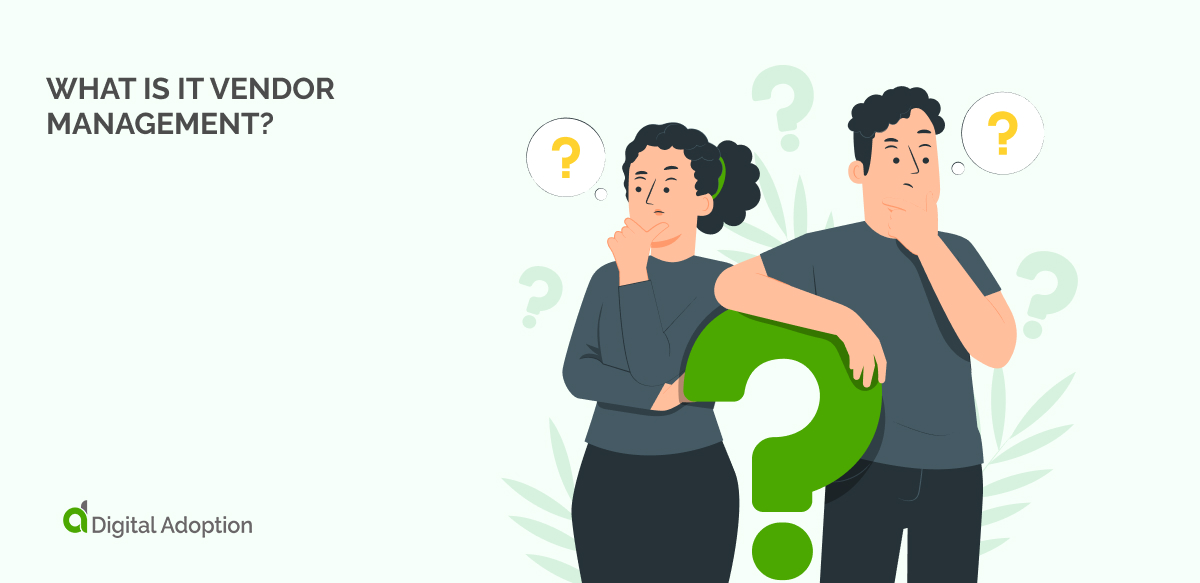
“vendor management” refers to how companies procure, monitor, and evaluate vendors to help achieve their business objectives.
In practical terms, vendor management occurs with every interaction between a company and its vendors. That might include update meetings, informal conversations, and shared reports. However, good vendor management relies on acquiring robust vendor data. A vendor management software system (or VMS) ensures businesses are making excellent decisions around vendors.
IT vendor management is a specialist area of vendor management. The vendor procurement and management process for digital services differs slightly from general vendor management. Software and hardware capabilities are constantly changing, requiring specialist knowledge from vendor management staff. Furthermore, data around IT processes can be far more vulnerable than others.
As such, a global increase in IT outsourcing has led to more demands on IT vendor management. Although IT vendor management now has its own specialists, best practices within general vendor management also apply to IT.
In large companies, a separate team will deal with procurement, one of the most important steps in the vendor management lifecycle.
Benefits of an Agile IT Vendor Management Process
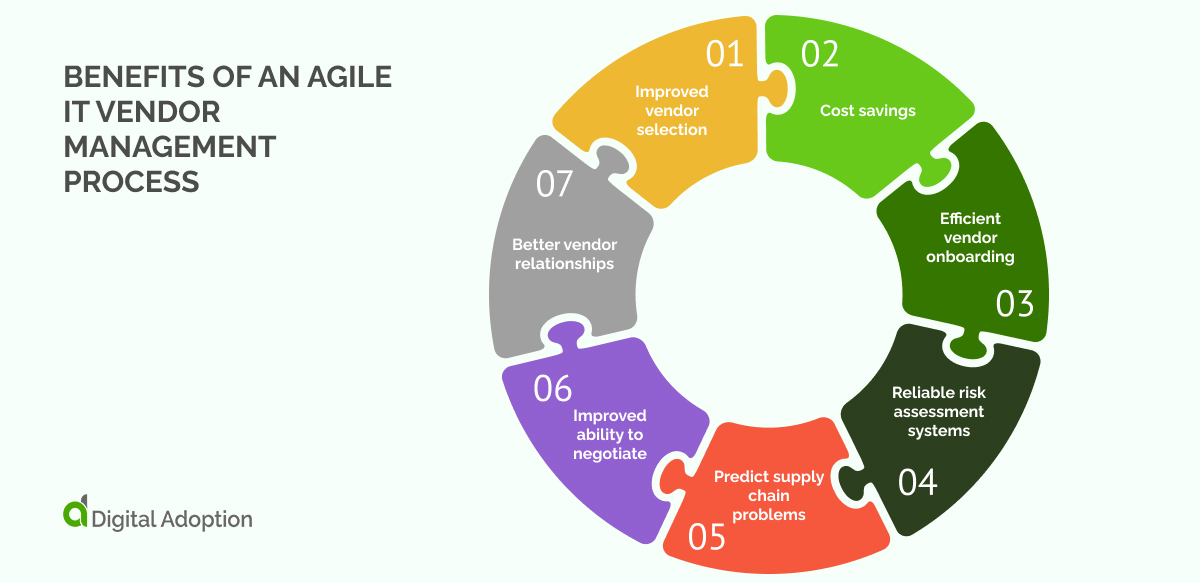
Businesses will implement a formal vendor management process to achieve one or more of the following aims:
- Improved vendor selection
- Cost savings
- Efficient vendor onboarding
- Reliable risk assessment systems
- Predict supply chain problems
- Improved ability to negotiate
- Better vendor relationships
Even with poor records of vendor information, a small business with superficial vendor relationships may be able to handle these areas. But as a company grows in scale and vendor contracts become more complex, keeping track of progress and creating a vendor offboarding checklist is important.
The agile approach to project management can bring many benefits to a company. It’s well known that Agile management begins with a simple set of priorities, including:
- Regular face-to-face interactions between individuals
- Producing workable solutions on short timescales
- Collaborating closely with customers and other stakeholders
- Responding positively to change at any stage of a project
Agile working is more popular now than it has ever been. And in a world beset by radical changes, this makes sense: Agile makes organizations highly resilient and capable of swift changes.
Managing vendors with Agile will not always be simple, even in the best circumstances. The client and vendor must have closely aligned principles. Both sides must be ready for daily communication, regular negotiation, and iterative deliverables. Buy-in and commitment will be essential. If a vendor’s business model is not agile, the partnership must take a different direction.
Vendor management software can be beneficial for Agile working environments. It will automatically keep tabs on key performance indicators and all vendor-related information.
The Challenges of IT Vendor Management System
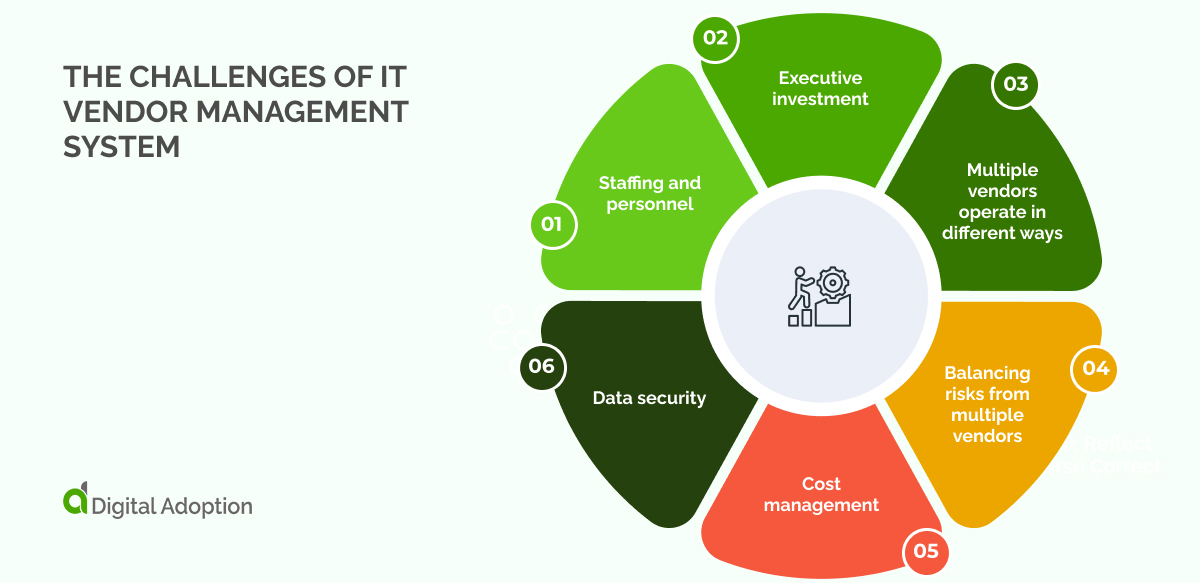
One of the central aims of proper vendor management is reducing vendor-related risks. However, good VMS systems can have challenges and problems that must be addressed from the outset.
Here are some examples of issues that may arise from vendor management systems:
- Staffing and personnel. Does the business have well-trained staff responsible for maintaining the vendor relationship? Without a solid vendor management team, you may run into problems.
- Executive investment. As with any digital system, a VMS for IT suppliers will struggle without management consistently supporting the package.
- Multiple vendors operate in different ways. Over time, good vendor management software will naturally help to standardize and streamline processes across the dozens of vendors in a business. But initially, how different vendors handle contracts, invoices, and compliance, can be a real mess.
- Balancing risks from multiple vendors. Even with a great vendor management process, risks will not go away. A VMS can help mitigate risks, but it will not make them disappear.
- Cost management. The price of running an effective VMS should help ensure your relationships work effectively. However, the prices of the right staff and software can be high. A complete evaluation before implementation can identify problems.
- Data security. Vendor management software is handy for consolidating and standardizing data. However, it’s important to remember that these systems make data vulnerable to attack. A survey by Statista showed that 50% of companies had seen increases in cyberattacks in 2021. As such, businesses that are serious about their vendor management system also need to be serious about protecting their data.
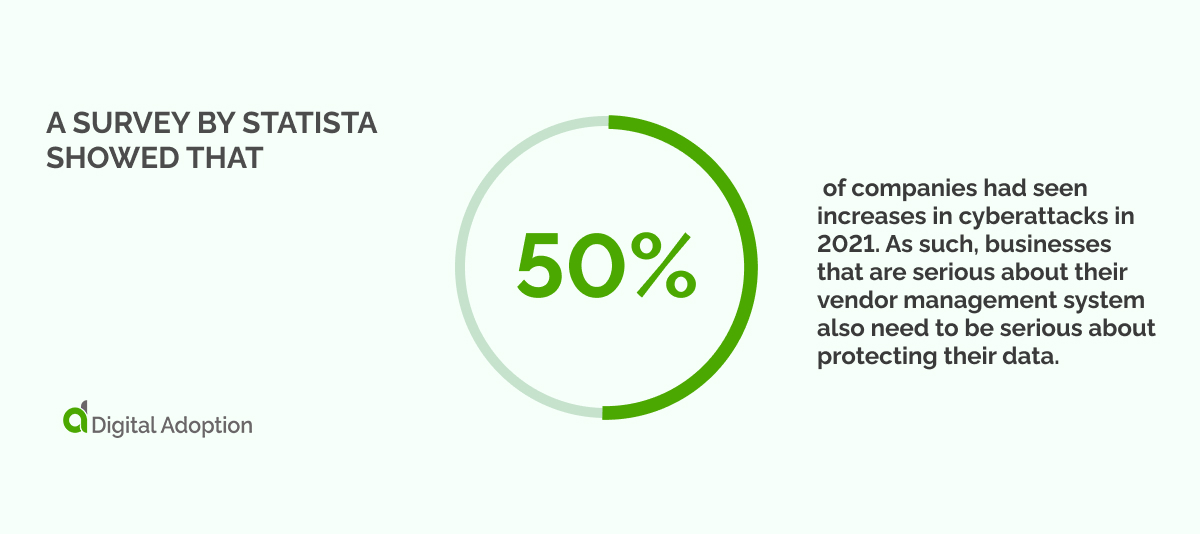
By keeping these areas in mind, the vendor management team will help mitigate risks while meeting company objectives.
It’s also worth remembering that the exact implementation of a vendor management system can be challenging. After all, a VMS will aim to solve problems that may have been embedded in a business for a long time.
Before the roll-out of a VMS, a business may have poor control over vendor data, no consistent understanding of vendor risks, and erratic relationship management with suppliers. A vendor management team must carefully plan its digital adoption strategy for companies like this.
10 Steps To Building A Strategic IT Vendor Management Process
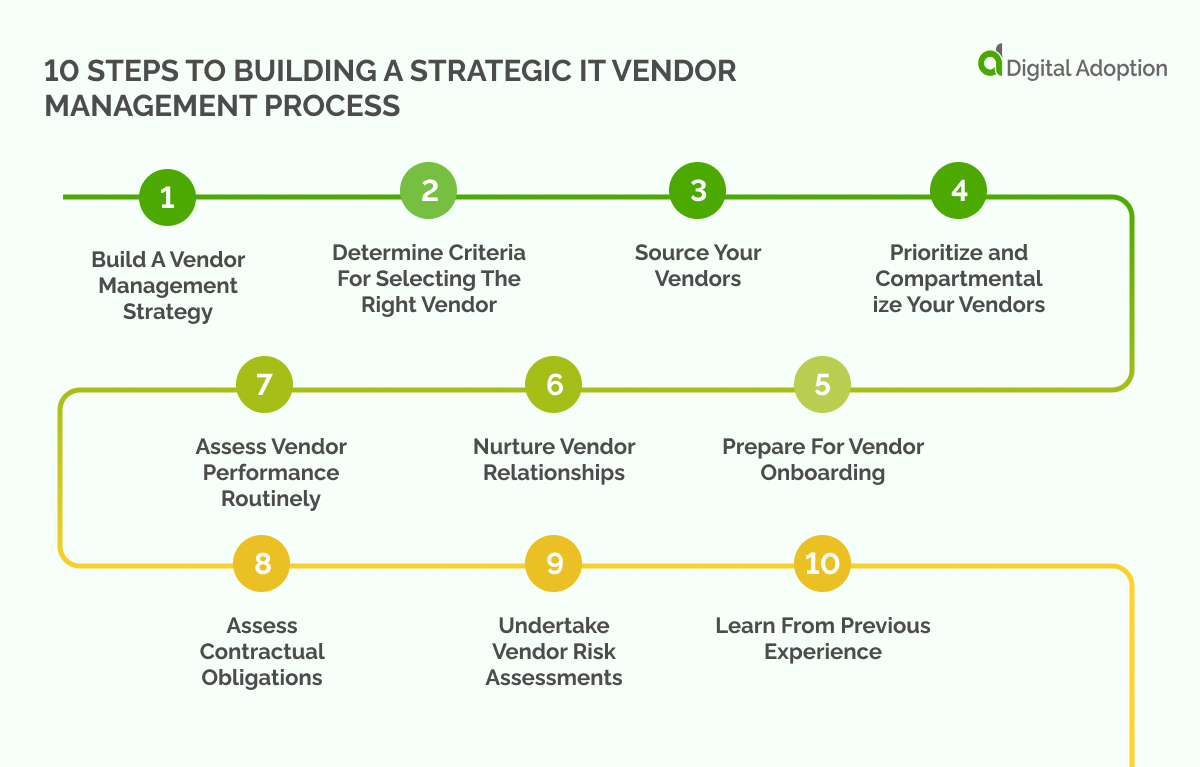
Improving a company’s overall vendor management takes serious time and effort. It will work much better if long-term goals underpin the strategic process.
Gartner has enhanced evaluation criteria for IT vendor selection. Achieving high marks in the evaluation criteria will improve a company’s chances of winning a deal.
IT vendor selection is important for any company looking to stay competitive in the fast-evolving tech landscape. In recent years, Gartner has significantly enhanced the criteria used to evaluate vendors and assign them ranking scores in its Magic Quadrant report.
This enhanced evaluation process is designed to help companies make more informed decisions when choosing a vendor for their IT needs. It considers factors like the vendor’s market share, competitive positioning, and product quality.
To achieve high ranks in Gartner’s evaluation criteria, vendors must demonstrate a robust product roadmap and commitment to innovation. They must also provide reliable customer support and maintain a solid reputation in the industry.
1. Build A Vendor Management Strategy
Strategic vendor management takes active control of the full process. With a good strategy, a vendor manager can look at a vendor’s overall contribution to the company.
Whereas procurement teams mainly exist to control costs, a practice of strategic vendor management will comprehensively assess quality and reliability. A good vendor management strategy will consider a potential vendor’s full-service package.
Some organizations invest in a Vendor Management Office (a VMO) to ensure their strategy is effective. VMOs are especially useful for managing complex IT relationships.
2. Determine Criteria For Selecting The Right Vendor
The criteria for assessing a vendor will vary, but a formalized approach will ensure that vendor selection can occur quickly.
One simple (but effective) model for vendor evaluation is the ’10 Cs’ model produced by Roy Carter. The 10 Cs remind companies to consider financial information alongside the more comprehensive value a vendor may bring.
3. Source Your Vendors
For niche IT services, even shortlisting appropriate vendors can be difficult. A company that does not understand the market well may employ an IT consultant to ensure they have the most up-to-date market knowledge.
4. Prioritize and Compartmentalize Your Vendors
Vendor segmentation helps to assess vendor performance against the most relevant criteria. Some critical vendors will be a vital part of a company’s growth, making them strategic partners.
Other suppliers will be less crucial but difficult to change. And another group of vendors will be transactional, providing necessary goods and services that would nonetheless be replaceable.
The expectations and risks around each of these groups should be different. Strategic vendors are essential for their overall contribution to the business (not just price). However, this may be the main criteria for transactional vendors.
5. Assess Contractual Obligations
Vendor contract management will change according to the culture of the company. An Agile organization may focus more on short-term goals and outcomes. While more traditional methods will consider the needs for years to come. Either way, having a standardized contract for suppliers can make onboarding significantly easier.
6. Prepare For Vendor Onboarding
As mentioned earlier in this article, a solid vendor portal is an excellent step toward effective onboarding, monitoring, and reporting on progress and development. Problems can still arise at this stage, so sorting them out as soon as possible is essential.
7. Nurture Vendor Relationships
There are plenty of ways a business can enhance its relationship with vendors. Even though the vendor management process often deals with large companies and impersonal transactions, taking a “personal touch” can go a long way.
This may involve check-in phone calls, thoughtful meetings, and corporate gifting. Vendor relationship management is an integral part of the overall strategy.
8. Assess Vendor Performance Routinely
A positive relationship benefits both vendor and client.
However, it’s still necessary to keep a close eye on the performance of each vendor. To do so, effective and reliable data tracking is a crucial tool. With real-time data monitoring, it’s then possible to track vendor performance over time: both here and now, at quarterly intervals, and annually.
If a vendor falls short on its key performance indicators, taking action as soon as possible is essential.
9. Undertake Vendor Risk Assessments
With a vendor comfortably on board, it may be easy to forget the risks that may still emerge from the relationship. However, the risk management process must constantly assess the success and dangers of an IT vendor’s contribution to the business.
A 2022 Gartner report suggested that perceived and actual risks differed. While 22% of companies experienced problems with compliance (the most common risk), only 10% believed it to be the most significant anticipated risk. Vendor management professionals know the real dangers and learn how to tackle them.
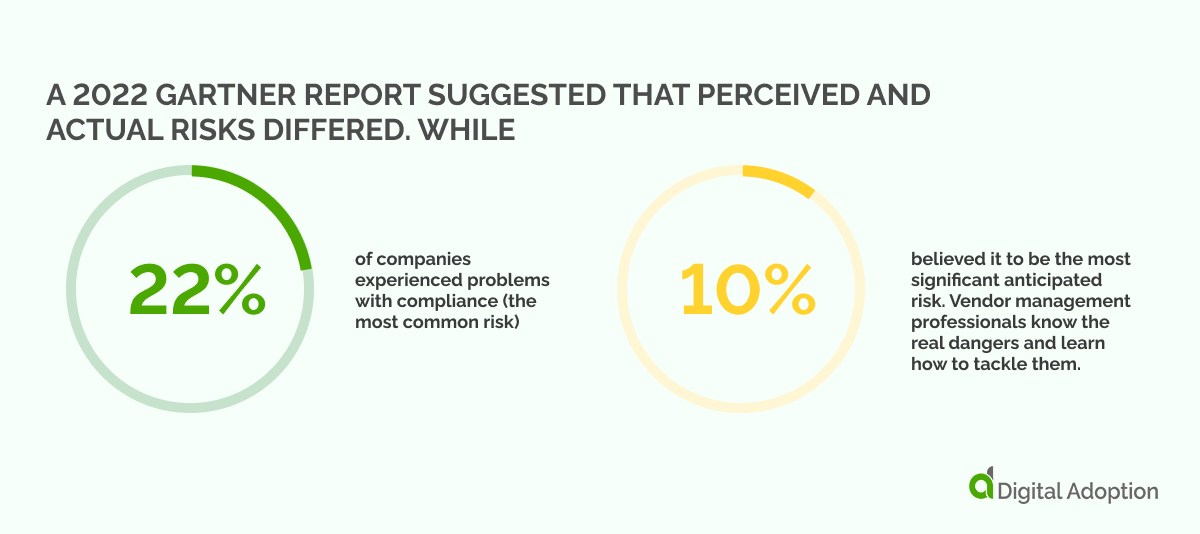
10. Learn From Previous Experience
Even the best vendor management processes will never be perfect. With all the expertise and experience, the world constantly creates new problems for a stable supply chain.
IT Vendor Management: A Recap
Even large companies don’t need a dedicated IT vendor management office. But every business needs a clear IT vendor management strategy. Building relationships with vendors, monitoring vendor performance, managing risk, and achieving service excellence will all be difficult without it. You risk delivery failure, supply chain disruption, data security issues, and more – that’s bad news for your business goals.
So just to recap. IT vendor management covers everything between a business and its technology vendors. When you do this well, realizing the full benefits of your investments is much easier. Although it comes with many challenges, a ten-step approach is an effective way to build your IT vendor strategy.













